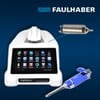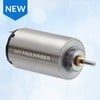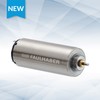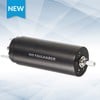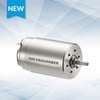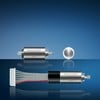Laboratory Equipment need Fast Reliable DC Motors
Featured Product from FAULHABER MICROMO
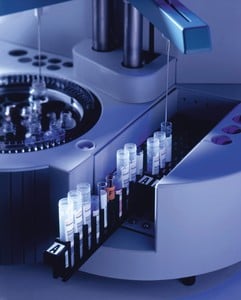
Fast, Reliable and Cost-Effective
Many standard recurring jobs in routine medical laboratory work are being performed through partial automation and additional manual work involving increased staffing levels, e.g. blood group determination or anti-body tests. Massive savings can be achieved by using state-of-the-art laboratory analysis systems. Their special design enables continuous, fast and reliable laboratory work while deploying fewer members of staff and providing an increased level of safety. It goes without saying that the systems correspond to the common safety requirements in function as well as evaluation performance. Analysis unit, computer and drives are adapted to the challenges of long-term medical usage.
STRATEC Biomedical Systems AG plans, develops and produces fully automated analysis systems designed specifically for use in clinical-diagnostic laboratories. Committed to delivering on-stop solutions, the company integrates dispensing, incubation and wash technology right up to complex liquid handling systems. The associated embedded and PC software, including the approval documentation for the systems, is also created in-house.
Laboratory Analysis Under Control
One of the main challenges in the area of liquid handling is the fast and target-oriented control of several items, e.g. on spot plates. Within this context, the dynamics of the process pose a particular challenge. The relatively substantial weights (one to three kg) of the moved actuators must be accelerated and decelerated rapidly. Speeds of up to 1 m/s must be controlled safely and with the utmost precision. In fact, accurate and repeatable positioning is decisive within this respect. Freely programmable positioning is a precondition for accessing the various plates and sample holders. Of course, the electronics and the drives must observe all the applicable safety regulations and EMC specifications for medical devices. The mechanical drive must also guarantee effective start-stop operation as part of heavy-duty usage.
Tailor-made for routine jobs
In practically every large hospital it is a standard practice to conduct tests as a way of medical intervention and treatment. These analyses are performed by the medical laboratory. A number of different steps and samples or reagents are necessary as part of these highly complex processes. For example, sample preparation, distribution, dilution series or reagent additions in a lab may require several hundreds of exactly proportioned and very precise liquid additions. Manual or partially automated execution would require immense concentration and staff reliability. Automation is the perfect alternative. In fact, the standardized micro and spot plates or cuvettes used in the past can also be deployed when the above-mentioned tasks are performed in a fully automated environment. The high-precision analysis system works tirelessly without interruption and at constant speed, thus enhancing the safety of the findings and increasing cost-effectiveness in the lab.
Flexibility is the trump card in mechanical design and control. After all, depending on the analysis to be performed, the sample preparation requirements can vary considerably. In general, an automated arm has to be able to accept the samples or reagents quickly and transfer them in a targeted manner to different, very closely arranged small holders. What is decisive for the quality of the analysis is the exact positioning of the arm, or the precise assignment of the sample and reagent. In addition to blood group determination or immunological analyses, bio-technological analyses can also be processed with superior precision. All that remains to be done by the lab staff is to insert the necessary reagents and samples and specify the program. In the event of a quick emergency analysis, e.g. for a blood test during an emergency operation, some systems may even leave the standard program mode and process the individual case data in no time at all. Thus, despite the emphasis on fully automated work processes, flexible operations are ensured.
Small, strong, reliable
To keep the masses as small as possible for the dynamic function, only micromotors can be considered as drive elements. As the various analysis systems make very specific demands on the drive, a comprehensive range of micromotors is desirable. In search of excellence, the analysis systems developers have thus opted to collaborate with the micromotor specialist FAULHABER. The extensive portfolio of one-stop solutions, such as drives, associated gearheads and encoders for positioning, facilitates new developments and standard production processes. Hence, drives from this leading-edge range of products are used in nearly all products developed. Marcus Wolfinger, member of the Stratec executive board, explains this as follows: "Faulhaber drives are extremely dynamic, featuring very small footprints in relation to their output. The gearheads used can carry heavy loads and require very little space. The modular approach used provides plenty of scope when it comes to designing our equipment."
Thus, for instance, the company uses the Series 2657 and 2224 bell-type armature motor with integrated encoder. The highly dynamic ironless drive offers high performance in the smallest possible space. The graphite commutated motors of the 2657 Series, with a length of just 57 mm and a diameter of 26 mm, generate an output of 47.9 W at 85% efficiency. Boasting a continuous torque of 44 mNm and a stall torque of 285 mNm, the 156g drive is capable of setting in motion and stopping actuators weighing several kilos. The micro-sized precious metal commutated drives of the 2224 Series offer an output capacity of 4.05 W at speeds of up to 8000 rpm, although it is just 24.2 mm long and has a diameter of 22 mm. Depending on the model, the nominal operating voltage is 3, 6, 12, 18, 24 or 36 V - i.e. there is a suitable voltage range for practically every application.
The speed and torque of both series can be adapted to the requirements by means of specially designed gearheads. It is also possible to integrate encoders that are capable of creating up to 512 pulses per revolution. Tailor-made gears increase the resolution of the output significantly. This ensures that the exact position of the actuated system parts can be determined effectively. And yet, the units comprising motor, gearhead and encoder are so small that they can be integrated practically anywhere. This is complemented by a comprehensive range of power supply options.
The innovative solutions developed for analytical and diagnostic lab operations are a tribute to the interaction of expert knowledge in medical devices and micromotor expertise. Here, as in other areas, flexible solutions facilitate the automation of routine functions and free up human resources that can be deployed in other areas.
